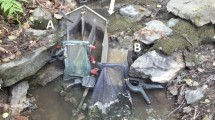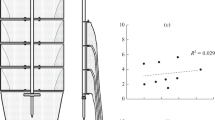Abstract
Are stream insects able to control their entry into the drift under all flow conditions? Do changes in streamflow patterns modify the typical drift patterns? Which larval instars are most affected by fluctuating flows? In order to document these questions, we studied the diel patterns in the drift density and size-structure of the heptagenid mayfly Rhithrogena semicolorata (Curtis, 1834) under natural and intermittent hydropeaking conditions in a mountain stream, i.e., up- and downstream of a hydroelectric power plant with hypolimnetic releases. Under natural conditions, drift exhibited a diel periodicity either during low flow periods (1 m3 s−1) and snowmelt floods (5 m3 s−1), nocturnal drift density being clearly higher. Larger individuals were found to drift at night. On the other hand, peak flows flushed many larvae downstream during the day. Smaller individuals were more affected by passive dislodgement, which resulted in a shift towards larger individuals in the size-composition of the benthic populations. When flow raised from 1 to 11 m3 s−1, the catastrophic drift occurring during the day depleted the benthos, and the nocturnal (active) drift was suppressed. However, the nocturnal drift was preserved when flow only raised from 5 to 10 m3 s−1.
Similar content being viewed by others
References
Allan, J. D., 1978. Trout predation and size composition of stream drift. Limnology and Oceanography 23: 1231–1237.
Céréghino, R. & P. Lavandier, 1996. Influence of hydropeaking on the structure and dynamics of invertebrate populations in a mountain stream. In Leclerc M. et al. (eds), Proceedings of the 2nd International Symposium on Hydraulics and Habitats, Québec, June 1996 Vol. A: 699-710.
Céréghino, R., P. Cugny & P. Lavandier, 2002. Influence of intermittent hydropeaking on the longitudinal zonation patterns of benthic invertebrates in a mountain stream. International Review of Hydrobiology 87: 47–60.
Ciborowski, J. J. H., 1987. Dynamics of drift and microdistribution of two Mayfly populations: a predictive model. Canadian Journal of Fisheries and Aquatic Sciences 44: 832–845.
Cobb, D. G., T. D. Galloway & J. F. Flannagan, 1992. Effects of discharge and substrate stability on density and species composition of stream insects. Canadian Journal of Fisheries and Aquatic Sciences 49: 1788–1795.
Crisp, D. T. & S. Robson, 1979. Some effects of discharge upon the transport of animals and peat in a North Pennine headstream. Journal of Applied Ecology 16: 721–736.
Culp, J. M., F. J. Wrona & R. W. Davies, 1985. Response of stream benthos and drift to fine sediment deposition versus transport. Canadian Journal of Zoology 64: 1345–1351.
Death, R. G., & M. J. Winterbourn, 1994. Environmental stability and community persistence: a multivariate perspective. Journal of the North American Benthological Society 13: 125–139.
Dytham, C., 2003. Choosing and using statistics. A biologist’s guide (2nd edition). Blackwell Publishing, Oxford. 248 pp.
Ghetti, P. F. & U. Ravanetti, 1984. The drift over one year of Plecoptera and Ephemeroptera in a small stream in Northern Italy. Archiv für Hydrobiologie 99: 478–488.
Gore, J. A., J. M. Nestler & J. B. Layzer, 1989. Instream flow predictions and management options for biota affected by peaking-power hydroelectric operations. Regulated Rivers: Research and Management 3: 35–48.
Gore, J. A., S. Niemela, V. H. Resh & B. Statzner, 1994. Near-substrate hydraulic conditions under artificial floods from hydropower operation: a preliminary analysis of disturbance intensity and duration. Regulated Rivers: Research and Management 9: 15–34.
Hauer, F. R. & J. A. Stanford, 1982. Ecological responses of Hydropsychid caddisflies to stream regulation. Canadian Journal of Fisheries and Aquatic Sciences 39: 1235–1242.
Irvine, J. R., 1985. Effects of successive flow perturbations on stream invertebrates. Canadian Journal of Fisheries and Aquatic Sciences 42: 1922–1927.
LeRoy Poff, N., R. D. DeCino & J. V. Ward, 1991. Size-dependent drift responses of mayflies to experimental hydrologic variation: active predator avoidance or passive hydrodynamic displacement? Oecologia 88: 577–586.
Moog, O., 1993. Quantification of daily peak hydropower effects on aquatic fauna and management to minimize environmental impacts. Regulated Rivers: Research and Management 8: 5–14.
Raddum, G. G., 1985. Effects of winter warm reservoir release on benthic stream invertebrates. Hydrobiologia 122: 105–111.
Waters, T. F., 1965. Interpretation of invertebrate drift in streams. Ecology 46, 327–334.
Waters, T. F., 1972. The drift of stream insects. Annual Review of Entomology 17: 253–272.
Wilzback, M. A., 1990. Nonconcordance of drift and benthic activity in Baetis. Limnology and Oceanography 35: 945–952.
Author information
Authors and Affiliations
Rights and permissions
About this article
Cite this article
Céréghino, R., Legalle, M. & Lavandier, P. Drift and benthic population structure of the mayfly Rhithrogena semicolorata (Heptageniidae) under natural and hydropeaking conditions. Hydrobiologia 519, 127–133 (2004). https://doi.org/10.1023/B:HYDR.0000026499.53979.69
Issue Date:
DOI: https://doi.org/10.1023/B:HYDR.0000026499.53979.69




